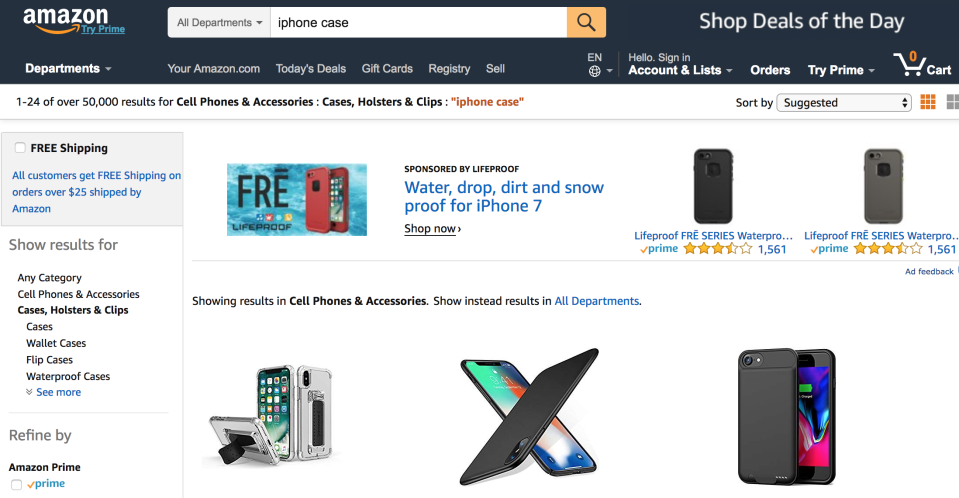Inside the vicious battle to show up on top of Amazon search
When an online retailer becomes big enough, it goes from being a place where stuff is strictly sold and shipped to something else: a platform powered by a search engine. With more than half a billion items, Amazon.com has long been as much a search service as it is an e-commerce giant.
Today, search dominates retail, though people rarely think about it as they scroll through its results. For the largest companies like Amazon, Walmart, and eBay, having an enormous shingle both nets favorable Google results but also draws customers to their sites to begin their search for particular products instead of going to Google.
As more and more of commerce has shifted online, many small retail businesses have considered Amazon and its ilk the same way a Triceratops might consider a meteor. But for small businesses that are willing to play the game by somebody else’s perhaps-unfavorable rules, these big companies’ online platforms provide selling opportunities. As its name suggests, Amazon’s marketplace doesn’t mean Amazon’s doing all the selling.
The “if you can’t beat ‘em, join ‘em” effect of countless small sellers on the platforms of Amazon, Walmart, eBay, Newegg, and others may have allowed these small businesses to mitigate conflict with Amazon, but it has essentially created a Circus Maximus environment in which the sellers are the gladiators competing with each other for sales and Amazon is Julius Caesar. All the while, the consumer is getting some wild deal with the promise of two-day shipping.

What it’s like to play the game
Neha Gajwani has been playing this game for a decade. As the CEO of SmackTom, a company that sells cases and accessories for electronic gadgets, she operates in one of the most cutthroat corners of e-commerce, filled with dirty tricks and customers who don’t care about brands.
For Gajwani, search results are almost everything to her bottom line.
“Nobody really goes past the first page when they search for something,” she said. “So it’s the difference in selling thousands of that product a day or none.”
Getting on that coveted first page of an Amazon product search is difficult and was something that took Gajwani five years to master, and during the entire interview with Yahoo Finance her guard was up to make sure she didn’t give up any trade secrets. When she started her business, she weighed setting up her own online storefront or selling through the marketplaces. She ended up choosing the latter for its convenience.
“I thought if I go on these marketplaces, they take care of at least one aspect of that: they have a customer,” she said. “I’ll set up a product and someone will buy it. And then, unfortunately, I realized that’s not how things worked.”
It quickly became clear that her products would not be at the top of the search results pages. The long road to experimentation involved tracking different keywords and looking at trends, something that took years to figure out.
“I tried this, I tried that,” she said. “I don’t think I figured out the right combination [of tactics] until five years later.”
Figuring it out
Amazon told Yahoo Finance that many algorithms and factors go into search results, but remain somewhat vague, allowing sellers to get an advantage if they can by figuring it out. Things aren’t over when a seller figures out how to stay at the top of the search game. While positive reviews, a large number of reviews, good sales, and a listing with descriptions containing language likely to be searched, all contribute to an item’s listing — sellers say, not Amazon — it’s a moving target that requires attention and flexibility.
“These marketplaces always have new requirements, things they’re testing,” said Gajwani. “All of that goes into where they put you in search.”
At any given point, Gajwani said, Amazon and other marketplaces have something in beta-testing. Right now, they’re testing customer satisfaction rates, which is charted after a seller and customer interact. Previously, she found herself without a paddle when Google suddenly stopped displaying eBay results in their search, a major problem. When that happened, she continued to try to sell her products on eBay but focused on other platforms. Next month it might be something completely different.
Dirty tricks and ‘every seller’s nightmare’
The most unpleasant part of figuring out how to live as an Amazon seller is when a fellow seller plays dirty, something that happens regularly. With such high stakes, it’s not surprising.
“It’s a very competitive landscape and it’s a dirty game,” said Gajwani.
Sometimes, it’s fake reviews that competitors arrange confederates to leave, boosting their profile and search results, as authentic reviews are the fastest way to obtain a good ranking. But often it’s far more nefarious.
“People will report you not having an authentic product,” said Gajwani. “Even if it’s not true, eBay or Amazon or Walmart have to investigate. If you’re selling a few thousand a day and holding inventory, that’s not a good place to be.”
In some cases, they suspend a few products, a lot, or the entire seller account, a potentially existential threat for a seller.
“That’s every seller’s nightmare,” said Gajwani. “It’s probably happened on average once or twice a year [to me]. The better you do, the more frequently I assume it happens,” because you’re blocking other sellers and they don’t like it.
Indirect offensive tactics are also frequent and just as dangerous. In many cases, if a seller has an Amazon listing, a competitor can come in and list a similar item at a lower price.
“In theory this is a good thing, but sometimes this translates to bad stuff,” said Gajwani. “Someone may claim to sell our product but deliberately sell a knockoff. Then Amazon will come to us and say we’re selling bad quality. And there’s no way to stop [counterfeits], unfortunately.”
Sellers are on their own
The relationship between sellers and marketplaces like Amazon is… complicated. “Amazon’s almost like a bad word in the seller community,” Gajwani said. “It’s a strong love-hate relationship where you hope nothing happens.”
A large part of that comes out of Amazon’s “customer obsession,” which, though it appears to be an eye roll-worthy corporate buzzword, is a very real thing that has implications for sellers.
“Their priority — and rightfully so — is the consumer. They’re better off being safe and will take you off to make sure everything’s OK,” said Gajwani, “Honestly, if I’m being objective I’m not sure if I disagree with that approach. But it does put you in a vulnerable position as a seller.”
In some cases, if both interests align, like when Amazon elected to ban reviews done in exchange for free stuff, a move that helps customers get accurate information and encourages sellers to play it straight.
For Amazon, which dominates the marketplace system over eBay, Walmart, and others, sellers like Gajwani live in fear of Amazon and prostrate themselves in front of the Seattle behemoth, just like politicians in the cities vying for Amazon’s second headquarters are doing with hefty tax breaks and flattery.
Gajwani said that her approach is very open and eager, a “take whatever you want” attitude when it comes to data. She proactively attaches data to any emails she sends, just to show how forthcoming and straight she’s playing it, without any funny business. Amazon, unlike other marketplaces, can afford to treat sellers like that.
“If you go to a Walmart or a Newegg or eBay, they’re definitely much more warm and just nicer — happier to listen and understand.”
Some people have given up and ditched the gore of Amazon’s Circus Maximus. Too many knockoffs undercutting prices and giving brands a bad name with bad quality.
But again, Gajwani said, it’s hard to blame Amazon.
“It’s just hard to enforce. You can get a complaint but it’s unclear who is doing what, who is lying, who is genuine, what kind of products is everyone selling,” she said. “To monitor that is a monster.”
Ethan Wolff-Mann is a senior writer at Yahoo Finance focusing on consumer issues, tech, and personal finance. Follow him on Twitter @ewolffmann.
This story is a part of Yahoo Finance Presents: The Retail Revolution , March 5-9, 2018.


